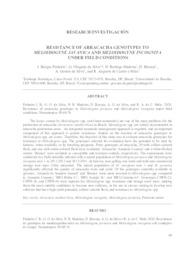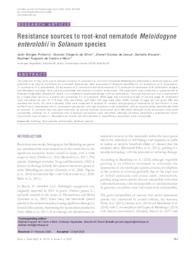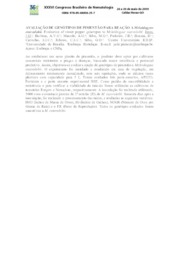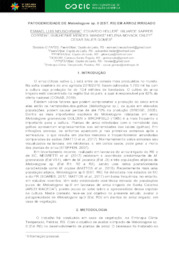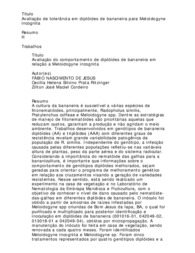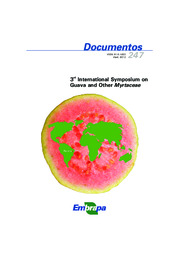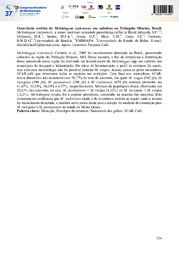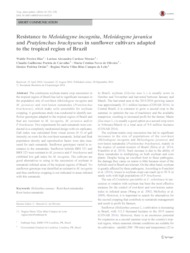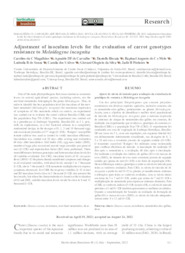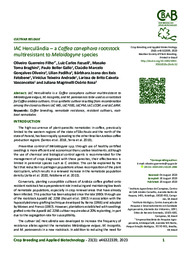Search Publications
Filter by:
| Author(s): PINHEIRO, J. B.; SILVA, G. O. da; MADEIRA, N. R.; BISCAIA, D.; SILVA, A. G. da; MELO, R. A. de C. e The objective of this study was to evaluate arracacha genotypes for resistance to Meloidogyne spp. The genotypes selected for evaluation have the potential to be used by farmers, when available, or by... ... |
| Author(s): PINHEIRO, J. B.; SILVA, G. O. da; JESUS, J. G. de; BISCAIA, D.; MELO, R. A. de C. e The objective of this work was to prospect sources of resistance to root-knot nematode Meloidogyne enterolobii in Solanum species with potential to be used as rootstocks for cultivated Solanaceae. Nin... ... |
| Author(s): JESUS, J. G.; BARBOSA, A. V. S.; MACEDO, A. G.; SILVA, M. G.; PINHEIRO, J. B.; BISCAIA, D.; CARVALHO, S. I. C. de; RIBEIRO, C. S. C.; SILVA, G. O. da Objetivou-se avaliar a reação de genótipos de pimentão a Meloidogyne enterolobii. |
| Author(s): NEUSCHRANK, E. L.; HELLER, E.; CORREIA, G. S.; MANSKE, G. M.; OXLEY, H. N.; GOMES, C. B. Teve-se por objetivo no presente estudo, avaliar a patogenicidade de Meloidogyne sp.0 (Est. R0) em plantas de arroz irrigado, em casa de vegetação. |
| Author(s): JESUS, F. N. de; RITZINGER, C. H. S. P.; CORDEIRO, Z. J. M. A cultura da bananeira é suscetível a várias espécies de fitonematóides, principalmente, Radopholus similis, Pratylenchus coffeae e Meloidogyne spp. Dentre as estratégias de manejo de fitonematóides s... ... |
| Author(s): CASTRO, J. M. da C. e; SANTOS, C. A. F.; FLORI, J. E. Brazil was the 7th world guava producer in 2008, producing 298,798 ton in 15,641 ha. However, the presence of the root-knot nematode, Meloidogyne enterolobii, has been caused severe loss to guava grow... ... |
| Author(s): ALMEIDA, S. F.; STAFANELO, D. R.; SANTOS, M. F. A.; SOUSA, G. P.; MAIA, Y. M.; CARES, J. E.; CARNEIRO, R. M. D. G. Meloidogyne izalcoensis Carneiro et al., 2005 foi recentemente detectada no Brasil, parasitando cafeeiros na região do Triângulo Mineiro, MG. Dessa maneira, a fim de determinar a distribuição desse ne... ... |
| Author(s): DIAS, W. P.; MORAES, L. A. C.; CARVALHO, C. G. P.; OLIVEIRA, M. C. N. de; LEITE, R. M. V. B. de C.; ORSINI, I. P. The continuous soybean-maize crop succession in the tropical region of Brazil has led to significant increases in the population size of root-knot (Meloidogyne incognita and M. javanica ) and root-les... ... |
| Author(s): MAGALHÃES, C. da C.; CARVALHO, A. D. F. de; BISCAIA, D.; MELO, R. A. de C. e; SOUZA, L. R. de; ALVES, C. dos S.; SILVA, G. O. da; PINHEIRO, J. B. Thus, in order to identify the best population level for inoculum of the rootknot nematode (Meloidogyne incognita) for maximum expression of symptoms of this nematode attack on carrots, an experiment... ... |
| Author(s): GUERREIRO FILHO, O.; FAZUOLI, L. C.; BRAGHINI, M. T.; GALLO, P. B.; OLIVEIRA, C. M. G.; PADILHA, L.; FATOBENE, B. J. dos R.; ANDRADE, V. T.; VASCONCELOS, L. de B. C.; ROSA, J. M. O. IAC Herculândia is a Coffea canephora cultivar multiresistant to Meloidogyne exigua, M. incognita, and M. paranaensis to be used as a rootstock for Coffea arabica cultivars. It is a synthetic cultivar... ... |
Observation
Some of Embrapa's publications are published as ePub files. To read them, use or download one of the following free software options to your computer or mobile device. Android: Google Play Books; IOS: iBooks; Windows and Linux: Calibre.
Access other publications
Access the Agricultural Research Database (BDPA) to consult Embrapa's full library collection and records.
Visit Embrapa Bookstore to purchase books and other publications sold by Embrapa.

